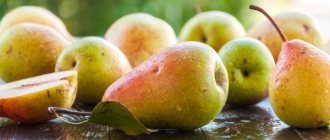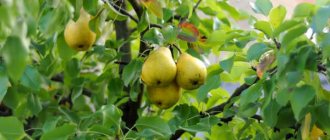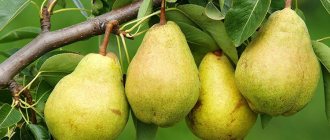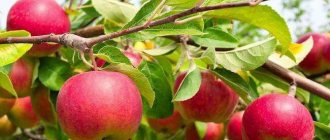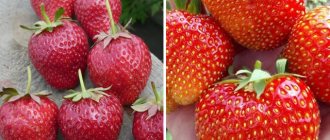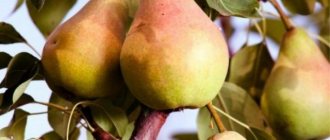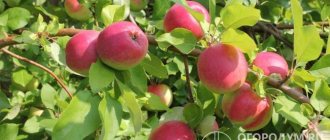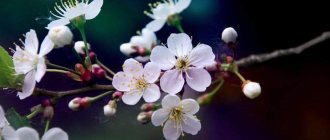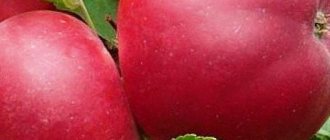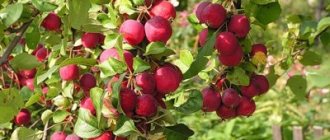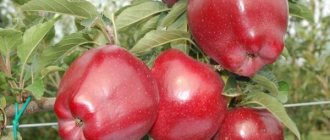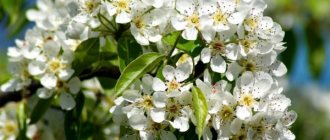Pear variety Nika.
Description of the variety
Pear is included in the group of winter varieties. Since 2002, the variety has been included in the State Register for the Central Black Earth region.
Characteristics of wood
The trees are small and their height is about 3-4 meters. The crown is rounded and not prone to thickening. The bark on the branches is brown. The leaves are small, green, and round in shape. The leaf plate is smooth.
Description of fruits
Nika.
The fruits are large and weigh about 130-200 grams. The shape of pears is truncated-conical. The main color of the fruit is light yellow. Most of the surface of the pear is covered with a dark red blush.
Nika fruits are juicy, sweet, with a slight sourness and oiliness in taste. Pear pulp has a characteristic nutmeg aroma.
The fruits are removed from the tree in late September. The harvested crop is stored until the end of January.
What type of pear is it?
Pear "Nika" is a winter variety with high frost resistance , down to -38°C. The fruits have the ability to be stored for a long time. The variety is universal in its purpose.
Winter pear varieties also include: Yanvarskaya, Yakovlevskaya, Chudesnitsa, Bere Russkaya and Feeriya.
Reviews
Olga
Gubkin
The pear has grown short, but bears fruit very well. After the branches are covered with ripe, red-sided fruits, the tree simply becomes a decoration for the garden.
Oleg Petrovich
Rossosh
The variety is hardy and persistent, but you still need to keep an eye on it and water and feed it on time. I closely monitor the health of the pear, and in return it makes me very happy with the quality and quantity of the harvest.
Fedor
Usman
At first I planted this pear alone on the plot, but after collecting several harvests, I realized that without a pollinator it wouldn’t work. The tree bore fruit very sparingly. After planting the Duchess and Williams varieties nearby, the situation changed radically.
Further care for Nika's pear
This pear variety should be watered several times a season. The first watering of a fruit tree is done at the moment the buds open. The next time this procedure is performed a couple of weeks after the first. For the third time, Nick's pear needs to be watered in the fall in the process of preparing the tree for winter.
After each watering, the soil is loosened, removing weeds, and then a layer of mulch is added, which will protect the roots of the tree from overheating during the summer season and will prevent the rapid evaporation of moisture and the growth of weeds.
Advice!
Before the buds appear, it is better to spray Nika’s pear with Bordeaux mixture or another preparation for preventive purposes, to protect it from possible diseases and pest attacks.
Landing
When choosing a site for planting Niki seedlings, you should give preference to areas with low groundwater levels. By clicking on the links below, you can find detailed instructions and tips for planting a pear tree.
How to plant a pear tree correctly
At what distance to plant pears?
How to choose pear seedlings
How to replant a pear
Pear Nika: reviews from those who grow
Natalya, 55 years old, Kaluga: I planted Nika’s pear tree on my plot several years ago. The tree was two years old. For several more years my pear grew rapidly. I even tried to bloom, but I tore off all the buds to give the tree the opportunity to quickly grow and get stronger. A Duchess pear grew next to me. 4 seasons after planting, my pear tree produced its first harvest. And thanks to the presence of a pollinating tree nearby, the yield was high. The harvest was collected in late September, the ripe fruits practically did not fall off. The taste of Nika's pear fruit is excellent, and all members of my family liked it.
Olga, 49 years old, Moscow region: Nika’s pear has been growing in our garden plot for 9 seasons. I would like to note that she definitely needs a pollinator tree nearby to get good harvests. In addition, I noticed that in the last couple of years small spots have appeared on the fruits - apparently over time the variety loses resistance to scab. Therefore, now every spring before flowering begins, I spray my pear against this disease. The taste of Nika pears is simply magnificent, they are so sweet that when making jam I put much less sugar than normal and add lemon so that it does not become sugary.
Thanks to its high yield and ease of care, the Nika pear variety is grown not only on private farms, but also on an industrial scale.
This tree does not require too much space in the garden, it is compact in size and is easier to prune and also harvest.
Care
Trees of this variety do not tolerate drought well, so you should regularly water the pear as needed. In the selection of articles below, you can find useful materials and recommendations for growing Nick's pear.
How to care for a pear Pruning a pear Pruning a columnar pear Treating a pear from diseases and pests Feeding a pear How to water a pear
Advantages
The main advantages of the Nika pear variety include:
- unpretentiousness in cultivation and care;
- high resistance to major diseases of pear trees;
- cold resistance and winter hardiness, so in the central regions of Russia it does not need to be covered for the winter;
- even if the shoots are frostbitten during the winter, they quickly recover during the summer season;
- the harvested crop is stored in appropriate conditions for at least 4 months;
- high tasting rating of ripe fruits;
- Thanks to the average size of the fruit tree, it is easy to collect ripe pears from it.
Interesting article:
Pear diseases
Nick's pear has no serious deficiencies. But it is worth noting that the tree requires regular pruning, and it is imperative to plant pollinating trees nearby.
Diseases and pests
The Nika variety has good disease resistance, but to maintain strong immunity and plant health, preventive maintenance should be carried out periodically. Useful information on the issue of protecting plants from diseases can be found in the articles selected below.
Dangerous Pear Pests
Pears often suffer from pests, they affect the leaves, bark and fruits.
In this article, we have selected 11 of the most harmful insects that harm pear trees, and also ways to destroy them.
Diseases of pear trees
To get what they cherish, gardeners have to work hard, and the reason for this is pear diseases.
Read about 19 common pear diseases and how to combat them.
Features of cultivation and subtleties of care
Proper care of Nika's pear involves a number of agrotechnical measures, such as watering, fertilizing, and pruning.
Recent Entries
5 working ways to use tar in the garden 7 indoor plants that help you get married even in adulthood Indoor plants that can bloom in trouble
Watering
Particular attention is paid to watering during the first time after planting the seedling so that the root system takes root normally. Subsequent irrigations should be infrequent, approximately once a month. However, it is worth considering climatic conditions: if the weather is hot and dry, watering should be more frequent. The procedure, despite its apparent simplicity, must be carried out correctly. The tree should not be watered with cold water or directly at the root. Otherwise, the roots are eroded and the plant is likely to die. Water consumption should be 2–3 buckets per 1 m² of tree trunk circle.
The pear must be watered with warm water into a trench prepared in advance.
For irrigation, use warm water that has been heated during the day in barrels or buckets. In addition, you need to dig a shallow trench around the tree and gradually introduce water into it. Upon completion of the procedure and absorption of water, the soil around the tree is loosened, which will prevent the formation of a soil crust. This technique improves air exchange, thereby improving the supply of oxygen to the root system.
To ensure moisture retention in the soil, it is recommended to mulch the surface of the tree trunk grooves after loosening.
Video: how to water a pear correctly
Top dressing
Since pears have a deep root system, fertilizers are applied superficially in most cases. For the first time, nutrients are added to the planting hole. Then Nika is fertilized in the fall, for which organic matter or mineral components are used. It should be taken into account that in the autumn, nitrogen is not needed for the tree, since it promotes the growth of vegetative mass. Based on this, fresh organic matter should be excluded. In this case, mineral fertilizers (phosphorus and potassium) are used, but on soils poor in humus, organic matter cannot be avoided. Therefore, after adding minerals, the soil is mulched with peat and humus in equal proportions, sprinkling the tree trunk circle with a layer of 15–20 cm.
Peat and humus are used as organic fertilizers on poor soils in equal proportions.
In autumn, fertilizers can be applied under digging or in the form of a nutrient solution. Liquid fertilizers are introduced into the soil through furrows 20–30 cm deep (the depth depends on the age of the tree). For digging add:
- 30 g granulated superphosphate;
- 15 g potassium chloride;
- 150 ml wood ash.
The figures are based on 1 m². To prepare the nutrient solution, the same components are used, with the exception of ash. Mineral fertilizers are diluted in 10 liters of water and applied into shallow furrows in the tree trunk circle with preliminary watering (2 buckets per 1 m²). In spring, pear trees need nitrogen to grow a lush crown. In this case, fertilizing can be carried out with one of the following compositions:
- 200 g of urea per 10 liters of water for 2 adult pears;
- 30 g of ammonium nitrate per 10 liters of water - for 2 pears;
- 500 g of bird droppings per 10 liters of water - leave for 24 hours and water 5 liters per tree.
In spring, the pear needs nitrogen, for which urea can be used
In the summer, for fruit formation, the crop needs more potassium and phosphorus, as well as microelements. When feeding, you can adhere to the following norm:
- phosphorus-containing substances - up to 300 g per bucket of water;
- potassium salt - up to 100 g per bucket of water;
- boron compounds - up to 20 g per bucket of water;
- copper-containing preparations - up to 5 g per 10 liters of water;
- products with magnesium - no more than 200 g per 10 liters of water;
- zinc sulfate - up to 10 g per bucket of water.
Pruning and further care
To regulate yield, fruit size, and also to prevent the development of diseases, pear trees must be pruned. The first time this procedure is performed is when planting: the branches of the seedling are shortened by 1/3 of the length. This will promote faster crown establishment. It is recommended to prune Nick's pear annually in early spring before the buds begin to bloom. If the shoot is completely removed, there is no need to leave the stumps. Those branches that with fruits descend to the ground and lie on it are also subject to removal. In addition, the tree needs thinning every year - do not allow the crown to thicken. Only strong and erect shoots should be left, and weak and crooked shoots should be removed. You need to trim no more than 1/4 of the total mass of branches.
When pruning a pear tree, the branches are cut so that no stumps remain.
If Nick's pear is not pruned, the crown quickly becomes bare and the fruits become small.
In the first year after planting a seedling of the variety in question, it is recommended to pick off most of the flowers. This technique improves the survival rate of the tree. In subsequent years, it is necessary to remove half of the newly established fruits, which reach only a few centimeters in diameter. The pursued goal of this procedure is to ration the harvest. As a result, the fruits that remain on the tree will have more weight, and the tree itself will be better prepared for the cold.
Pear variety Nika needs annual pruning, which allows you to regulate yield, fruit size, and prevent the development of diseases
Despite the fact that the Nika variety is quite frost-resistant, to protect young plantings from winters with little snow and high frosts, it is recommended to mulch the tree trunk circle with horse humus. In addition, the standard should be wrapped in non-woven material, for example, Agrotex. In this way, it will be possible to protect trees in the future, replacing whitewashing.
Video: how to prune a pear correctly
Winter variety GNU VNIIGiSPR im. I. V. Michurina. Authors: S.P. Yakovlev, A.P. Gribanovsky, N.I. Savelyev, I.A. Bandurko, M.Yu. Akimov, V.V. Chivilev. Obtained from crossing the Talgar Beauty and Daughter of the Dawn varieties. Zoned in the Central Black Earth region since 2002.
Tree
medium-sized, medium-growing, with a sparse rounded crown. The fusion of skeletal branches is strong. Mixed fruiting type.
Escapes
medium thickness, straight, brown, bare, few lentils, medium buds, conical, smooth. The leaves are medium-sized, round, short-pointed, green, smooth, shiny, with delicate nerves, the shape of the base is obtuse, the serration is finely serrated, the curvature is weak, the petiole is of medium length, the stipules are subulate.
Fruit
medium and above average size, weighing 140-200 g, truncated-conical, regular shape, smooth.
The skin is medium, smooth, oily, with a waxy coating. Color at the moment of removable maturity: main greenish, integumentary blurred, red; during the period of consumer maturity: the main one is light yellow, the outer layer is brownish-red over most of the fruit. The peduncle is medium, curved, oblique. The funnel is small, narrow, the calyx is open, non-falling, the saucer is very small, wide. The heart is small, round, the seed chambers are closed, the seeds are medium, conical, brown. The pulp is creamy, tender, medium density, semi-oily, fine-grained, juicy, without astringency or granulation, the taste is sweet and sour, with a pleasant aroma. Tasting score 4.5 points. The fruits
contain dry soluble substances - 15.7%, sugars - 10.2%, titratable acids - 0.40%, ascorbic acid - 6.2 mg/100g, P-active substances - 122.0 mg/100g. The fruiting period begins at 5-6 years. Productivity is high. Harvesting maturity occurs in the second ten days of September, the duration of the consumption period in the conditions of a refrigerated fruit storage is 90-100 days. Characterized by high winter hardiness. After artificial freezing in the middle of winter at -38°C, the degree of xylem damage did not exceed 0.6 points, the bark and cambium did not freeze. Not affected by scab and entomosporiasis.
Advantages of the variety:
long period of consumption, dessert taste of fruits, complex resistance to diseases.
Disadvantages of the variety:
without pruning, the crown quickly becomes exposed and the fruits become smaller.
Growing
Plants begin to bear fruit 4-5 years after planting. Frost resistance is high, up to -38ºС, which is quite enough for trouble-free cultivation at the latitude of Moscow. To the north, plants may freeze slightly, so they require shelter for the trunk and forks of skeletal branches. The ends of the shoots are restored well.
Description of the Otradnenskaya pear variety: characteristics, photos, reviews, video
Of the fungal diseases, Nika best resists scab and entomosporiasis. In addition to general health-improving measures: collecting fallen leaves, whitewashing the trunk, timely sanitary pruning and regular fertilizing, trees must be periodically inspected. This will allow you to notice signs of trouble in time and treat with chemicals.
Pears of this variety require annual pruning, which keeps them in good shape. Otherwise, the crown may become bare and the fruits may become smaller. Gardeners call this feature the main disadvantage. The branches are thinned out in the spring, and the cut areas are covered with garden varnish or paint.
Characteristic
Soviet scientists developed the Nika variety; this pear is included in the State Register and zoned for the Central Region with black earth soils. Nick's dwarf pear is primarily distinguished by its compact size - the tree grows only three to four meters in height. The appearance of the plant is also unusual - a spherical crown formed by skeletal branches extending from the trunk almost at a right angle.
Full characteristics of the Nika pear:
- shoots are of medium thickness, the trunk is covered with brown bark, the leaves are in the shape of a slightly pointed oval, slightly curved;
- the surface of the sheet is smooth, without a glossy sheen;
- Nika blooms with large white inflorescences;
- with age, the crown of a pear tree thins out - this is a characteristic feature of the variety;
- the shape of the fruit is regular, pear-shaped;
- the mass of fruits of the Nika variety is large - on average, 180 grams;
- when unripe, pears are colored green, reddish spots clearly appear on the peel, ripe fruits are yellow;
- the peel on the fruit is thin, smooth, there is a small layer of wax;
- the pulp of the fruit is creamy, with a delicate texture, very juicy;
- the taste qualities of Nika's pear are high: inside it is sweet and sour, without grain, with light notes of nutmeg;
- Nika should be harvested in mid-late September;
- consumer ripeness of the fruits occurs only in October - pears need to lie down to ripen;
- even when ripe, fruits filled with juice do not fall off the branches, therefore, if the weather permits, you can postpone the harvest until October;
- The harvest can be stored for three to four months;
- storage conditions - dry and dark room or storage with a constant temperature of 0 degrees;
- the productivity of the Nika variety is high;
- the fruiting phase of the variety begins early - 4-5 years after planting the tree;
- The tree has high frost resistance - Nika is able to withstand cold temperatures down to -38 degrees;
- Nika is resistant to fungal infections such as scab and entomosporiasis;
- This variety of pear is not demanding on soil composition, but does not like heavy waterlogging;
- the variety is partially self-sterile, that is, for good and stable harvests, Nika needs pollinating pears that will bloom at the same time;
- The purpose of the fruits is universal: fruits make aromatic jams, confitures, they can be used as a filling, made into wine or juice, or made into marmalade.
Advantages and disadvantages
Reviews from gardeners about Nika's pear are mostly positive. Owners of orchards note that this variety is problem-free and unpretentious: Nika is very easy to grow, it requires practically no care, and the tree rarely gets sick.
Nick's pear has several advantages:
- good frost resistance, which makes it possible not to cover trees in the central part of the country (including in the Moscow region);
- ability to regenerate - frostbitten branches quickly recover and begin to bear fruit;
- the fruits are stored for a long time and retain excellent presentation until spring;
- the tree has a strong immunity to fungal diseases;
- the fruits receive high tasting scores (not lower than 4.5 points out of five possible).
Like all garden crops, Nika has its own small disadvantages. Gardeners include:
- the need for regular crown pruning;
- Nicky's need for pollinators.
Of course, against the backdrop of the extreme unpretentiousness and listed advantages of Nick’s pear, all its disadvantages seem insignificant. Due to this, the variety is often grown both in private farms and in large gardens.
Harvest and storage
Harvesting takes place at the end of September - beginning of October, when the pears are green-brown in color (not ripe): they need to lie down and get ready. It is advisable to store fruits in a cool place at 0°C and high humidity. You can use a wooden box, the bottom of which will be covered with paper or sawdust. The pears are stacked in a checkerboard pattern. During storage (4–5 months), the crop must be sorted periodically.
Nick's pear can be grown freely in your own garden. Thanks to its compact size, it does not require much space and is easy to harvest. The fruits of this variety are famous for their excellent taste and good shelf life.
Pros and cons of the variety
Nika has its advantages and disadvantages. The positive aspects include:
- high productivity;
- partial self-fertility;
- high productivity;
- winter hardiness;
- unpretentious care;
- resistance to fungi;
- high taste qualities of fruits;
- transportability.
Disadvantages include the desirable presence of pollinators and constant tree pruning for crown formation and sanitation.
Fish for the human body: benefit or harm?
